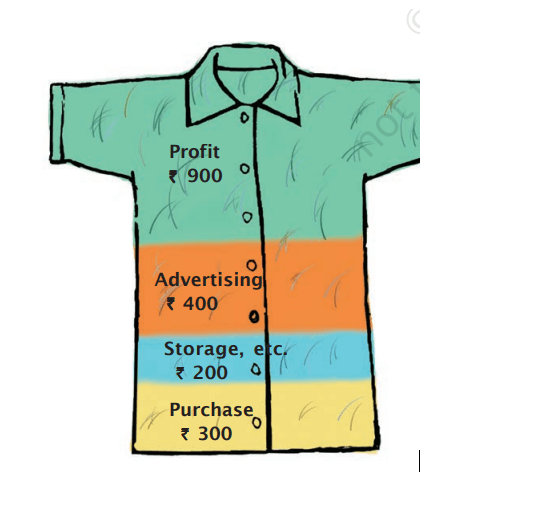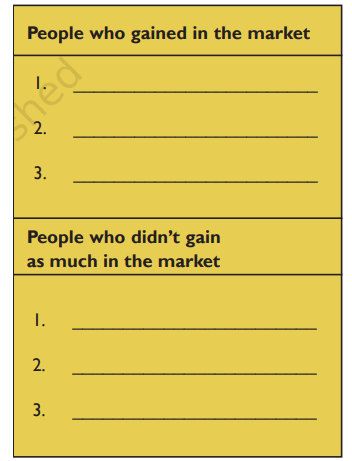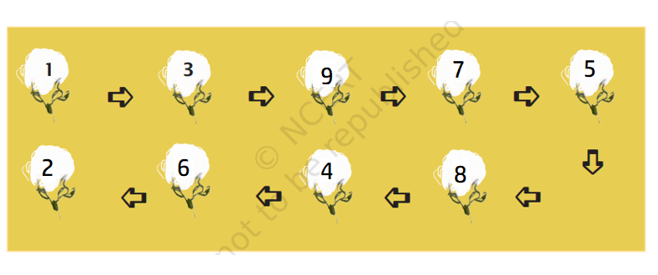Civics - Class 7
Social and Political Life II
Chapter 8: A Shirt in the Market
Intext Questions:
Question 1 :Did Swapna get a fair price on the cotton ?
Answer:No. Swapna didn’t get a fair price on the cotton.
Question 2 : Why did the trader pay Swapna a low price ?
Answer:The trader paid Swapna a low price on the cotton because she had borrowed money from him and promised to sell her cotton produce to him only.
Question 3 : Where do you think large farmers would sell their cotton ? How is their situation different from Swapna ?
Answer:
- Large farmers would directly sell their cotton either in the cotton market or to Ginning mill.
- Large farmers’ situation is different from Swapna. Swapna is a poor farmer who often borrows money from traders on high interest rate and is made to promise to sell her produce to trader on the price he fixes. But larger farmers are rich and don’t need money on interest to cultivate cotton plants. They invest their money and are not compelled to sell their produce to traders as happened in the case of Swapna. They are free to sell their produce anywhere to fetch reasonable price.
Question 4 :What are the following people doing at the Erode Cloth market merchants, weavers, exporters ?
Answer:
1.Merchants:: Merchants are doing the
following
activities at the Erode cloth market they buy the cloths made by weavers in the
villages. They also get the cloths made on order by the weavers. These merchants
supply
cloth on order to garment manufacturers and exporters around the country. They also
purchase yarn and give instructions to the weavers about the kind of cloth that is
to be
made.
2. Weavers:
Weavers make cloth in the village and bring in the Erode’s bi-weekly cloth market in
Tamil Nadu for sale. They also make cloths on order from the merchant. For this,
they
get the yarn from the merchant and supply him the cloth.
3. Exporters: Exporters buy cotton cloths
from
merchants and use these cloths to make shirts. They export or sell these shirts to
foreign buyers in the US and Europe who run a chain of stores there. These
exporters,
the owners of the garment exporting factory get the maximum work out of the workers
at
the lowest possible wages so that they can maximise their profits on supplying the
garments to foreign buyers.
Question 5 :In what ways are weavers dependent on cloth merchants ?
Answer:
- The weavers get the work from the merchants based on the orders the merchants have received for the type and quantity of cloth.
- The weavers are dependent on merchants as they get the yarn from the cloth merchants and supply them with the cloth. Thus, the weavers are dependent on the merchants both for raw material and markets.
Question 6 :If the weavers were to buy yarn on their own and sell cloth, they would probably earn three times more. Do you think this is possible? How ? Discuss?
Answer:Yes. This is possible. Because the yarn, the weavers buy from merchants is on the credit of high price and high-interest rate of the cost. But they cannot sell the woven cloth in the market on their own. They have to sell these clothes to merchants who pay very little for them. So, if the weavers were to buy yarn on their own and sell cloth, they would probably earn three times more.
Question 7 :Do you find similar ‘putting out’ arrangements in making papads, masalas, bidis? Find out about this in your area and discuss it in class.
Answer:Yes, I find similar 'putting
out'
arrangements in making papads, masalas, bidis in my local area, where rich people
give
the raw materials to workers and make their products done.
Advantages:
- Employment has been created.
- Division of labour is respected.
- End products are being achieved with money.
- No worry for raw materials for poor people.
- Workers involved in making papads, masalas, bidis are compelled to work with low wages for long hours.
- Work shops use short-term wage workers.
- These arrangements involved middlemen, like Agents, Merchants.
- In these entire chain of production, the poor are deprived of fair share/ price.
Question 8 :You might have heard of co¬operatives in your area. It could be in milk, provisions, paddy, etc. Find out for whose benefit they were set up?
Answer:There is milk cooperative in my area. In this cooperative, the milkmen with common interests come together and work for their mutual benefit. This milk cooperative collects the milk from all the milkmen and sell to the milk factory at a reasonable price. The milkmen also get advance through the cooperative without interest and buy cows and buffaloes. Thus, they develop their milk business with the help of cooperatives.
Question 9 :What are the demands foreign buyers make on the garment exporters? Why do the garment exporters agree to these demands?
Answer:The foreign buyers do business on their own terms and conditions. They demand the lowest prices of garments from the garment exporters. In addition, they also set high standards for quality of production and timely delivery. Any defects or delay in delivery is dealt with strictly. The garment exporters agree to the demands of foreign buyers because they earn high profits from this order.
Question 10 :How do the garment exporters meet the conditions set by the foreign buyers?
Answer:
- The garment exporters try to cut the costs of the garment. They fill this cut by getting the maximum work from the workers at the lowest possible wages.
- This way they supply the garments to foreign buyers at a cheap price. Thus, the garment exporters meet the conditions set by the foreign buyers.
Question 11 :Why do you think more women are employed in the Impex garment factory? Discuss.
Answer:
- The women are not well educated and belong to a poor family, try to earn some money instead of staying at home.
- These women become ready to work in garment exporting factories at a monthly wage of as low as 1500 rupees. They think this amount is an additional earning for the family. But at this rate, probably no man agrees to work. This is the reason, why more women are employed in the Impex garment factory.
Question 12 :
Answer:
From
Bindu Rao
5/3, Mandir Marg Gole Market
New Delhi-110001
Date: 25-06-2021
To
The Minister
Ministry of Labour and Social Welfare
Government of Delhi
Subject: An application’ regarding proper payment to the workers.
Sir,
With due respect, I want to draw your kind attention towards the wages, the workers
mainly women get in a garment exporting factory. They are given Rs. 1,500 to Rs. 2,000
per month. This is less than the minimum wages fixed by the government. So, please take
this case for your supervision and try to take legal action so that they can get proper
payment which I think should be more than Rs. 3000 per month.
Thanking you.
Yours’ sincerely,
Bindu Rao
Question 13 :The shirt below shows the profit made by the businessperson, and the various costs that he had to pay. Find out from the diagram below, what the cost price include.

Answer:
The cost price is Rs. 1800.
It includes =
Purchase – Rs. 300/-
Storage – Rs. 200/-
Advertising – Rs. 400/-
profit- 900/-
Total cost price = Rs. 1800/-
Question 14 :Compare the earnings per shirt of the worker in the garment factory, the garment exporter, and the business¬person in the market abroad. What do you find?
Answer:Comparative earnings per shirt of
the worker, the garment exporter and the businessperson in the market abroad are as
follow :
I found that the worker earns the minimum i.e., Rs. 25 per shirt. And the businessman in
the market abroad earns the maximum earning, i.e., Rs.1800 per shirt. Whereas, the
garment exporter earns more than five times what a worker earns and six times less than
the businesspersons in the market abroad.
Question 15 : What are the reasons that the business person is able to make a huge profit in the market?
Answer:
- Investment of money is the main reason to make a profit in the market.
- The person who invests as much money and the power to decide the deal earns as much profit.
- Here the businessperson is the richest and most powerful in dealing with the garment business. So he makes a huge profit in the market.
Question 16 : You have read the chapter on advertising. Why does the businessperson spends 300/- per shirt on advertisement? Discuss
Answer:
- Making a brand is the key process in the business to make a profit. As the brand will be popular in the market and the consumer’s mind, it will do business.
- As “a result, the brand owner makes profit from the sale of the products of the brand.
- And it is the advertising that develops a brand in the market. This is the reason why the businessperson spends Rs. 300 per shirt on advertising.
Question 17 : Fill up the table given below:

Answer:People who gained in the market
- Businesspersons in the market abroad (the most)
- Garment exporters
- Merchants or trades
- Workers in the garment export factory
- Weaver, making cloths
- Farmers, growing and selling cotton
Exercises
Question 1 : What made Swapna sell the cotton to the trader instead of selling at the Kurnool cotton market?
Answer:Swapna sold the cotton to the trader instead of selling at the Kurnool cotton market because:
- At the beginning of the cropping season, Swapna had borrowed Rs 2,500 from the trader at a very high interest rate to buy seeds, fertilisers, pesticides for cultivation.
- So, she promised to sell all her cotton to him.
Question 2 : Describe the conditions of employment as well as the wages of workers in the garment exporting factory. Do you think the workers get a fair deal?
Answer: A)Conditions of employment in the garment exporting factory:
- Workers are employed on a temporary basis means they can be asked to leave anytime when not needed.
- They have pressure to produce quality products in limited time.
- They have to do hard work for long hours.
Question 3 : Think of something common that we use. It could be sugar, tea, milk, pen, paper, pencil, etc. Discuss through what chain of markets this reaches you. Can you think of the people that help in the production or trade?
Answer:Chain of markets to produce Milk is first produced in
- Dairy cooperatives first purchase milk at different locations.
- After that, milk is transported to the milk factories by the dairy cooperatives.
- Milk is pasteurised in the factories and are packed.
- Packets milk are then given to the traders which transport them to cities where wholesaler purchase these.
- Retailers purchase from the wholesalers then sell these packets of milk to the consumers in the open market in booths.
Question 4 : Arrange the statements given alongside in the correct order and then fill in the numbers in the cotton bolls accordingly. The first two have already been done for you.
1.Swapna sells the cotton to the trader.
2.Customers buy these shirts in a supermarket.
3.Trader sells cotton to the Ginning Mill.
4.Garment exporters buy the cloth from merchants for making shirts.
5.Yarn dealers or merchants give the yarn to the weavers.
6.The exporter sells shirts to the businessperson from the USA.
7.Spinning mill buys the cotton and sells yarn to the yarn dealers.
8.Weavers return with the cloth.
9.Ginning mill cleans the cotton and makes it into bales.
Answer:

1.Swapna sells the cotton to the trader.
3.Trader sells cotton to the Ginning Mill.
9.Ginning mill cleans the cotton and makes it into bales.
7.Spinning mill buys the cotton and sells yarn to the yarn dealers.
5.Yarn dealers or merchants give the yarn to the weavers.
8.Weavers return with the cloth.
4.Garment exporters buy the cloth from merchants for making shirts.
6.The exporter sells shirts to the businessperson from the USA.
2.Customers buy these shirts in a supermarket.